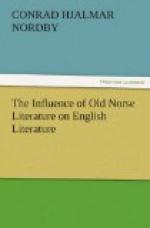It was to be expected that one so enthusiastic about antiquities as Scott would early discover the treasury of Norse history and song. At twenty-one, as we see, he is transcribing a song in a language he knew nothing about, as well as in translations. Fourteen years later, he has learned enough about the subject to write a review of Herbert’s Poems and Translations.[14]
In 1813, he writes an account of the Eyrbyggja Saga for Illustrations of Northern Antiquities (edited by Robert Jameson, Edinburgh, 1814).
There are two of Scott’s contributions to literature that possess more than a mere tinge of Old Norse knowledge, namely, the long poem “Harold, the Dauntless” (published in 1817), and the long story “The Pirate” (published in 1821). The poem is weak, but it illustrates Scott’s theory of the usefulness of poetical antiquities to the modern poet. In another connection Scott said: “In the rude song of the Scald, we regard less the strained imagery and extravagance of epithet, than the wild impressions which it conveys of the dauntless resolution, savage superstition, rude festivity and ceaseless depredations of the ancient Scandinavians."[15] The poet did his work in accordance with this theory, and so in “Harold, the Dauntless,” we note no flavor of the older poetry in phrase or in method. Harold is fierce enough and grim enough to measure up to the old ideal of a Norse hero.
“I was rocked in a buckler and fed from a blade,” is his boast before his newly christened father, and in his apostrophe to his grandsire Eric, the popular notion of early Norse antiquarianism is again exhibited:
In wild Valhalla hast thou
quaffed
From foeman’s skull
metheglin draught?
Scott’s scholarship in Old Norse was largely derived from the Latin tomes, and such conceptions as those quoted are therefore common in his poem. That the poet realized the inadequacy of such knowledge, the review of Herbert’s poetry, published in the Edinburgh Review for October, 1806, shows. In this article he has a vision of what shall be when men shall be able “to trace the Runic rhyme” itself.
“The Pirate,” exhibited the Wizard’s skill in weaving the old and the new together, the old being the traditions of the Shetlands, full of the ancestral beliefs in Old Norse things, the new being the life in those islands in a recent century. This is a stirring story, that comes into our consideration because of its Scandinavian antiquities. Again we find the Latin treasuries of Bartholinus, Torfaeus, Perinskjoeld and Olaus Magnus in evidence, though here, too, mention is made of “Haco,” and Tryggvason and “Harfager.” With a background of island scenery, with which Scott became familiar during a light-house inspector’s voyage made in 1814, this story is a picture full of vivid colors and characters. In Norna of the Fitful Head, he has created a mysterious personage in whose




